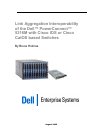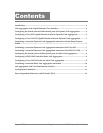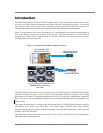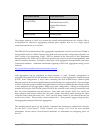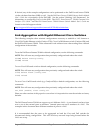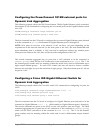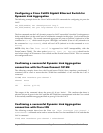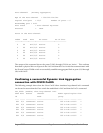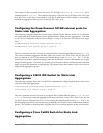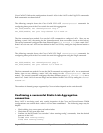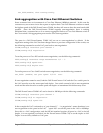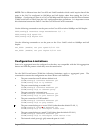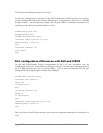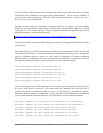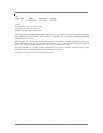
August 2005 Page 6 Dell Enterprise Product Group
Configuring the PowerConnect 5316M external ports for
Dynamic Link Aggregation
The following example shows the Dell PowerConnect 5316M Gigabit Ethernet switch command-
line interface (CLI) commands for configuring the six external ports on the Gigabit Ethernet switch
for LACP.
5316M(config)# interface range ethernet g11-16
5316M(config-if)# channel-group 1 mode auto
The first command sets the CLI mode to configure the six external Gigabit Ethernet ports (referred
to in the command as g11-16, which stands for Gigabit Ethernet ports 11 through 16).
NOTE: All 6 ports do not have to be selected; a LAG can have 0-6 ports depending on the
requirements of the network network (i.e the more ports in the LAG, the more bandwidth and
more redundancy that is available). A LAG can even be configured without any member ports.
When ports are added to the LAG, they will be set to the configuration of the LAG.
The second command aggregates the six ports into a LAG (referred to in the command as
channel-group), which will use LACP (referred to in the command as mode auto). The ‘1’ for
the channel-group number only has meaning within the switch and is used to differentiate up to
eight unique channel-groups. For each LAG created, the user will need to choose a number
between one and eight, for up to the maximum of eight groups. Only the external ports (11-16) can
be part of a LAG
Configuring a Cisco IOS Gigabit Ethernet Switch for
Dynamic Link Aggregation
The following example shows the Cisco IOS switch CLI commands for configuring six ports for
LACP.
3750(config)# interface range GigabitEthernet 1/0/1 - 6
3750(config-if)# channel-protocol lacp
3750(config-if)# channel-group 1 mode active
The first command sets the CLI mode to configure six Gigabit Ethernet ports (referred to in the
command as Gigabit Ethernet 1/0/1 – 6, which stands for Gigabit Ethernet ports 1 through 6).
The second command sets ports to use LACP as the LAG protocol (and not PAgP). The third
command aggregates the six ports into a LAG (referred to in the command as channel-group),
which will use LACP (referred to in the command as mode active). The ‘1’ for the channel-
group number only has meaning within the switch and is used to differentiate unique channel-
groups



